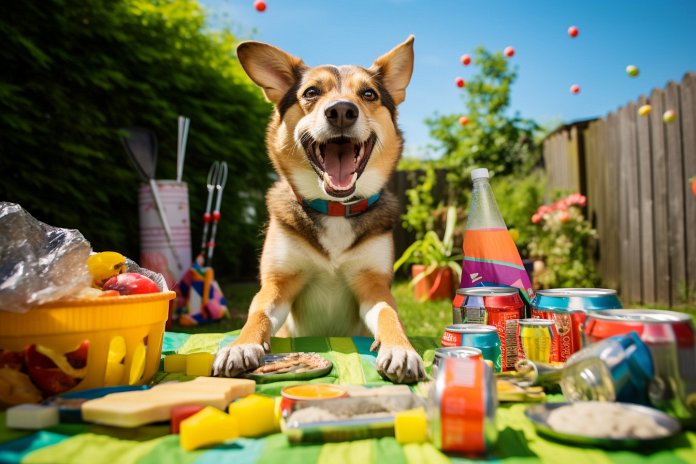
When you think of fizzy food, you might think of soda pop, beer, or champagne. Fizzy foods can also include fruits treated with carbonation to enhance their flavor. However, it’s important to note that sharing fizzy food with your dog is not a good idea. Dogs are attracted to sweet tastes, but many fizzy foods can contain substances that are harmful to them.
Signs Your Dog May Show While Eating Fizzy Food
Unlike humans, dogs can’t communicate their enjoyment or discomfort with words. Some dogs may devour anything in their bowl or around the house, while others may be picky eaters. It’s crucial to observe your dog’s reactions to food and be aware of any signs that may indicate a negative response.
Your dog may show curiosity when encountering fizzy food, tilting their head and focusing intently on the food. On the other hand, some dogs may become scared, exhibiting low body posture, hiding, and trembling. There are also dogs that may consume fizzy food without showing any noticeable reactions.
While carbonation itself is not harmful to dogs, it’s the other ingredients in fizzy food that can be dangerous. It’s important to be vigilant about what your dog eats and any signs of digestive issues or other adverse reactions. If you notice any problems, it’s best to seek advice and treatment from a veterinarian.
Body Language
When reacting to fizzy food, dogs may exhibit various signs, including alertness, head tilting, shaking, cowering, low tail carriage, and ears being up. Other signs that may indicate a negative reaction to fizzy food include surprise, vomiting, diarrhea, flatulence, lethargy, loss of appetite and weight loss, and fever.
The History of Fizzy Food
Carbonated water was discovered in 1767 and was later developed into carbonated beverages with added flavors like lemon and honey. In the early 19th century, carbonated drinks became popular for their perceived health benefits. Fizzy foods, on the other hand, were accidentally discovered when a neurobiologist bit into a pear that had absorbed carbon dioxide from dry ice. Fizzy foods have since expanded to include various fruits and even yogurt, appealing to children and promoting healthier eating habits.
The Science of Fizzy Foods in Dogs
Dogs have taste receptors that allow them to distinguish between sweet, sour, bitter, and salty flavors, but they have fewer taste receptors than humans. Dogs predominantly rely on their sense of smell, which is more important to them than taste. While fizzy foods may enhance taste slightly for dogs, unless the enhancement is through scent, fizzy food doesn’t offer anything special for dogs to savor.
Sharing fizzy foods with dogs can be concerning due to the high sugar content, the presence of toxic substances like Xylitol in diet sodas, and the potential inclusion of fruits that dogs should not consume. It’s best to stick to water and a balanced dog diet to keep your dog healthy.
Training Your Dog to Eat Veggies
Ensuring your dog has a balanced diet that includes vitamins and minerals from vegetables and fruits is important. To introduce your dog to vegetables, start by adding small amounts of new foods to familiar foods. Some safe and healthy options include grated carrots, mashed cooked carrots, canned pumpkin, broccoli flowerets (avoiding the stems), and cooked turnip. Remember not to overfeed your dog and consult with your veterinarian for the best dietary choices.
Keep Your Dog Safe with Food Choices
Avoid teasing your dog with exploding candies and refrain from giving them beer or drinks with yeast. Dogs should only drink water, and it’s important to keep human food out of their reach.
“Choose water over fizz to keep your furry friend safe and healthy.”

Tips & Things to Know
1️⃣ Avoid sharing fizzy food with your dog: While dogs may like the sweet taste of fizzy food, it is not a good idea to share it with them. Fizzy foods may contain substances that are harmful to dogs, so it’s best to stick to water for their hydration needs.
2️⃣ Be alert to your dog’s reactions to food: Dogs have different reactions to food, so it’s important to be a good observer of your dog’s behavior during feeding. Look out for signs of discomfort or digestive issues, such as vomiting, diarrhea, or flatulence. If your dog is not well, contact your veterinarian for proper advice and treatment.
3️⃣ Introduce safe fruits and vegetables to your dog’s diet: Instead of giving your dog fizzy food, consider incorporating safe fruits and vegetables into their diet. Carrots, broccoli, pumpkin, and turnips are some examples of dog-friendly options. Start by adding small amounts of new foods to familiar ones and consult with your veterinarian for the best diet for your dog. Remember not to overfeed them.
Frequently Asked Questions, Answered ✅
1. Why is it not a good idea to share fizzy food with your dog?
– Fizzy foods may contain substances that are potentially harmful to dogs.
2. What are some signs that your dog may show if they have eaten fizzy food?
– Signs can include head tilting, shaking, cowering, low tail carriage, and ears up.
3. What are some potential dangers of fizzy food for dogs?
– Fizzy foods may contain ingredients that are dangerous for dogs, such as sugar, caffeine, and Xylitol.
4. What are some signs of a problem if your dog has eaten something harmful?
– Signs can include vomiting, diarrhea, flatulence, lethargy, loss of appetite, weight loss, and fever.
5. How can you train your dog to eat vegetables?
– You can introduce small amounts of safe vegetables, such as carrots, broccoli, pumpkin, and turnips, gradually into their diet.